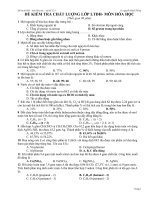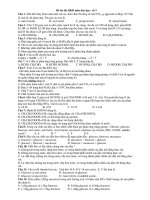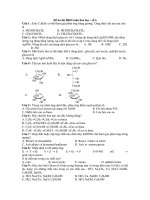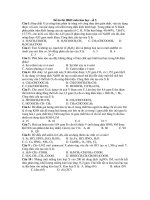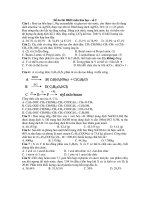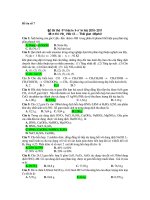Đề ôn thi thử môn hóa (592)
Bạn đang xem bản rút gọn của tài liệu. Xem và tải ngay bản đầy đủ của tài liệu tại đây (129.07 KB, 5 trang )
e1
References
1. Najafi A, Sequeira V, Kuster DWD, et al. b-adrenergic receptor
signalling and its functional consequences in the diseased heart. Eur
J Clin Invest. 2016;46(4):362-374.
2. O’Connell TD, Jensen BC, Baker AJ, et al. Cardiac Alpha 1-adrenergic receptors: novel aspects of expression, signaling mechanisms,
physiologic function, and clinical importance. Pharmacol Rev. 2014;
308-333.
3. Alberts B. Molecular Biology of the Cell. New York: Garland Publishing; 1994.
4. Kamp TJ, Hell JW. Regulation of cardiac L-type calcium channels by
protein kinase A and protein kinase C. Circ Res. 2000;87(12):1095-1102.
5. Guimarães S, Moura D. Vascular adrenoceptors: an update. Pharmacol Rev. 2001;53(2):319-356.
6. Piascik MT, Perez DM. Alpha1-adrenergic receptors: new insights
and directions. J Pharmacol Exp Ther. 2001;298(2):403-410.
7. Graham R. Alpha1-adrenergic receptors. In: D. Robertson, editor.
Primer on the Autonomic Nervous System, 2nd ed. Boston: Elsevier;
2004;50-53.
8. Park MK. Use of digoxin in infants and children, with specific emphasis on dosage. J Pediatr. 1986;108(6):871-877.
9. Michelotti GA, Price DT, Schwinn DA. Alpha 1-adrenergic receptor
regulation: basic science and clinical implications. Pharmacol Ther.
2000;88(3):281-309.
10. Jensen BC, O’Connell TD, Simpson PC. Alpha-1–Adrenergic Receptors in Heart Failure. J Cardiovasc Pharmacol. 2014;63(4):291-301.
11. Somlyo AP, Somlyo AV. Signal transduction and regulation in
smooth muscle. Nature. 1994;372(6503):231-236.
12. Andersen G, Qvigstad E, Schiander I, et al. Alpha(1)-AR-induced
positive inotropic response in heart is dependent on myosin light
chain phosphorylation. Am J Physiol Heart Circ Physiol.
2002;283(4):H1471-H1480.
13. Minneman KP. Alpha 1-adrenergic receptor subtypes, inositol phosphates, and sources of cell Ca21. Pharmacol Rev. 1988;40(2):87-119.
14. Smiley RM, Kwatra MM, Schwinn D. New developments in cardiovascular adrenergic receptor pharmacology: molecular mechanisms
and clinical relevance. J Cardiothorac Vasc Anesth. 1998;12(1):80-95.
15. Leone M, Albanèse J, Martin C. Positive inotropic stimulation. Curr
Opin Crit Care. 2002;8(5):395-403.
16. Garcia-Sainz JA, Vazquez-Prado J, del Carmen Medina L. Alpha
1-adrenoceptors: function and phosphorylation. Eur J Pharmacol.
2000;389:1-12.
17. Singh M, Notterman DA, Metakis L. Tumor necrosis factor produces homologous desensitization of lymphocyte beta 2-adrenergic
responses. Circ Shock. 1993;39(4):275-278.
18. Rochais F, Vilardaga JP, Nikolaev VO, et al. Real-time optical recording of b1-adrenergic receptor activation reveals supersensitivity of the
Arg389 variant to carvedilol. J Clin Invest. 2007;117(1):229-235.
19. Holmes CL, Patel BM, Russell JA, et al. Physiology of vasopressin
relevant to management of septic shock. Chest. 120(3):989-1002.
20. Jackson EK. Vasopressin and other agents affecting the renal conservation of water. In: Hardman JG, Limbird LE, Molinoff B, et al.,
eds. Goodman and Gillman’s The Pharmacological Basis of Therapeutics.
New York: McGraw-Hill; 1996:715-732.
21. Hasser EM, Bishop VS, Hay M. Interactions between vasopressin
and baroreflex control of the sympathetic nervous system. Clin Exp
Pharmacol Physiol. 1997;24(1):102-108.
22. Luk J, Ajaelo I, Wong V, et al. Role of V1 receptors in the action of
vasopressin on the baroreflex control of heart rate. Am J Physiol.
1993;265(3 Pt 2):R524-R529.
23. Undesser KP, Hasser EM, Haywood JR, et al. Interactions of vasopressin with the area postrema in arterial baroreflex function in
conscious rabbits. Circ Res. 1985;56(3):410-417.
24. Holmes. Physiology of vasopressin relevant to mgmnt of septic
shock. Chest. 2001;120(3):989.
25. Nemenoff RA. Vasopressin signaling pathways in vascular smooth
muscle. Front Biosci. 1998;3:d194-d207.
26. Choong K. Vasopressin in pediatric critical care. J Pediatr Intensive
Care. 2016;5(4):182-188.
27. Webb JG, Yates PW, Yang Q, et al. Adenylyl cyclase isoforms and
signal integration in models of vascular smooth muscle cells. Am J
Physiol Heart Circ Physiol. 2001;281(4):H1545-H1552.
28. Chandrashekhar Y, Prahash AJ, Sen S, et al. The role of arginine
vasopressin and its receptors in the normal and failing rat heart. J
Mol Cell Cardiol. 2003;35(5):495-504.
29. Birnbaumer M. Vasopressin receptors. Trends Endocrinol Metab.
2000;11(10):406-410.
30. Dousa TP. Cyclic-3’,5’-nucleotide phosphodiesterase isozymes in cell
biology and pathophysiology of the kidney. Kidney Int. 1999;55(1):
29-62.
31. Movsesian MA. PDE3 cyclic nucleotide phosphodiesterases and the
compartmentation of cyclic nucleotide-mediated signalling in cardiac myocytes. Basic Res Cardiol. 2002;97(suppl 1):I83-I90.
32. Farah AE, Frangakis CJ. Studies on the mechanism of action of the
bipyridine milrinone on the heart. Basic Res Cardiol. 1989;84(1):85-103.
33. Schlepper M, Thormann J, Kremer P, et al. Present use of positive
inotropic drugs in heart failure. J Cardiovasc Pharmacol. 1989;
14(suppl 1):S9-S19.
34. Shipley JB, Tolman D, Hastillo A, et al. Milrinone: basic and clinical
pharmacology and acute and chronic management. Am J Med Sci.
1996;311(6):286-291.
35. Chatterjee K. Newer oral inotropic agents: phosphodiesterase inhibitors. Crit Care Med. 1990;18(1 Pt 2):S34-S38.
36. Yano M, Kohno M, Ohkusa T, et al. Effect of milrinone on left
ventricular relaxation and Ca(21) uptake function of cardiac sarcoplasmic reticulum. Am J Physiol Heart Circ Physiol. 2000;279(4):
H1898-H1905.
37. Skoyles JR, Sherry KM. Pharmacology, mechanisms of action and
uses of selective phosphodiesterase inhibitors. Br J Anaesth. 1992;
68(3):293-302.
38. Schwinger RH, Bundgaard H, Muller-Ehmsen J, et al. The ATPase
in the failing human heart. Cardiovasc Res. 2003;57:913.
39. Fambrough DM, Lemas MV, Hamrick M, et al. Analysis of subunit
assembly of the Na-K-ATPase. Am J Physiol. 1994;266(3 Pt 1):
C579-C589.
40. Wang J, Schwinger RH, Frank K, et al. Regional expression of sodium pump subunits isoforms and Na1-Ca11 exchanger in the
human heart. J Clin Invest. 1996;98(7):1650-1658.
41. Artman M, Henry G, Coetzee WA. Cellular basis for age-related
differences in cardiac excitation–contraction coupling. Prog Pediatr
Cardiol. 2000;11(3):185-194.
42. Shigekawa M, Iwamoto T. Cardiac Na(1)-Ca(21) exchange: molecular and pharmacological aspects. Circ Res. 2001;88(9):864-876
43. Schmidt TA, Allen PD, Colucci WS, et al. No adaptation to digitalization as evaluated by digitalis receptor (Na,K-ATPase) quantification in explanted hearts from donors without heart disease and from
digitalized recipients with end-stage heart failure. Am J Cardiol. 1993;
71(1):110-114.
44. Bohn DJ, Poirier CS, Edmonds JF, et al. Hemodynamic effects of
dobutamine after cardiopulmonary bypass in children. Crit Care
Med. 1980;8(7):367-371.
45. Akita T, Joyner RW, Lu C, et al. Developmental changes in modulation of calcium currents of rabbit ventricular cells by phosphodiesterase inhibitors. Circulation. 1994;90(1):469-478.
46. Friedman WF, George BL. New concepts and drugs in the treatment of congestive heart failure. Pediatr Clin North Am. 1984;31(6):
1197-1227.
47. Swedlow DB, Raphaely RC, eds. Cardiovascular Problems in Pediatric Critical Care. New York: Churchill Livingstone; 1986.
48. Mielgo V, Valls i Soler A, Rey-Santano C. Dobutamine in paediatric
population: a systematic review in juvenile animal models. PLoS
One. 2014;9(4):e95644.
49. Hoffman BB, Taylor P, Hardman JG, et al. Neurotransmission. In:
Goodman and Gilman’s the Pharmacologic Basis of Therapeutics.
New York: McGraw Hill; 1996.
e2
50. Kopin IJ. Catecholamine metabolism: basic aspects and clinical
significance. Pharmacol Rev. 1985;37:333-364.
51. Moran JL, O’Fathartaigh MS, Peisach AR, et al. Epinephrine as an
inotropic agent in septic shock: a dose-profile analysis. Crit Care
Med. 1993;21(1):70-77.
52. Steel A, Bihari D. Choice of catecholamine: does it matter? Curr
Opin Crit Care. 2000;6:5.
53. Smolich JJ, Cox HS, Esler MD. Contribution of lungs to desipramine-induced changes in whole body catecholamine kinetics in
newborn lambs. Am J Physiol. 1999;276(1 Pt 2):R243-R250.
54. Friedgen B, Wölfel R, Graefe KH. The contribution by monoamine
oxidase and catechol-O-methyltransferase to the total-body and
pulmonary plasma clearance of catecholamines. Naunyn Schmiedebergs Arch Pharmacol. 1996;353(2):193-199.
55. Li YH, Wirth T, Huotari M, et al. No change of brain extracellular
catecholamine levels after acute catechol-O-methyltransferase inhibition: a microdialysis study in anaesthetized rats. Eur J Pharmacol.
1998;356(2-3):127-137.
56. Allen E, Pettigrew A, Frank D, et al. Alterations in dopamine clearance and catechol-O-methyltransferase activity by dopamine infusions in children. Crit Care Med. 25(1):181-189.
57. Chu CA, Sindelar DK, Neal DW, et al. Hepatic and gut clearance of
catecholamines in the conscious dog. Metabolism. 1999;48(2):259-263.
58. Eisenhofer G, Rundquist B, Aneman A, et al. Regional release and
removal of catecholamines and extraneuronal metabolism to metanephrines. J Clin Endocrinol Metab. 1995;80(10):3009-3017.
59. Notterman DA, Greenwald BM, Moran F, et al. Dopamine clearance in critically ill infants and children: effect of age and organ
system dysfunction. Clin Pharmacol Ther. 1990;48(2):138-147.
60. Goldberg LI, Rajfer SI. Dopamine receptors: applications in clinical
cardiology. Circulation. 1985;72(2):245-248.
61. Van den Berghe G, de Zegher F, Lauwers P. Dopamine suppresses
pituitary function in infants and children. Crit Care Med.
1994;22(11):1747-1753.
62. Chernow B, ed. Essentials of Critical Care Pharmacology. Baltimore:
Williams & Wilkins; 1994.
63. Beregovich J, Bianchi C, Rubler S, et al. Dose-related hemodynamic
and renal effects of dopamine in congestive heart failure. Am Heart
J. 1974;87(5):550-557.
64. Goldberg LI. Dopamine—clinical uses of an endogenous catecholamine. N Engl J Med. 1974;291(14):707-710.
65. Matayoshi Y, Sari A, Nagai K, et al. Hemodynamic effects of
dopamine in critically ill patients (author’s transl). Masui. 1979;28(8):
791-796.
66. Gundert-Remy U, Penzien J, Hildebrandt R, et al. Correlation between the pharmacokinetics and pharmacodynamics of dopamine in
healthy subjects. Eur J Clin Pharmacol. 1984;26(2):163-169.
67. Seri I, Abbasi S, Wood DC, et al. Regional hemodynamic effects of
dopamine in the sick preterm neonate. J Pediatr. 1998;133(6):728-734.
68. Subhedar NV, Shaw NJ. Dopamine versus dobutamine for hypotensive preterm infants. Cochrane Database Syst Rev. 2003;(3):CD001242.
69. Gupta S, Donn SM. Neonatal hypotension: dopamine or dobutamine? Semin Fetal Neonatal Med. 2014;19(1):54-59.
70. Barrington KJ. Circulatory effects of dopamine in neonates. J Pediatr.
1995;127(5):843-844.
71. Perez CA, Reimer JM, Schreiber MD, et al. Effect of high-dose dopamine on urine output in newborn infants. Crit Care Med. 1986;
14(12):1045-1049.
72. Padbury JF, Agata Y, Baylen BG, et al. Dopamine pharmacokinetics
in critically ill newborn infants. J Pediatr. 1987;110(2):293-298.
73. Seri I, Abbasi S, Wood DC, et al. Regional hemodynamic effects
of dopamine in the sick preterm neonate. J Pediatr. 1998;133(6):
728-734.
74. Wong FY, Barfield CP, Horne RSC, et al. Dopamine therapy promotes cerebral flow-metabolism coupling in preterm infants. Intensive Care Med. 2009;35(10):1777-1782.
75. Juste RN, Moran L, Hooper J, et al. Dopamine clearance in critically
ill patients. Intensive Care Med. 1998;24(11):1217-1220.
76. MacLeod CM. Drugs used in the acutely ill patient. Dis Mon.
1993;39(6):362-501.
77. McEvoy GK, ed. Dopamine hydrochloride. In: AHFS Drug Information. Bethesda, MD: American Society of Health-System Pharmacists; 2009.
78. Eldadah MK, Schwartz PH, Harrison R, et al. Pharmacokinetics of
dopamine in infants and children. Crit Care Med. 1991;19(8):1008-1011.
79. Berg RA, Padbury JF, Donnerstein RL, et al. Dobutamine pharmacokinetics and pharmacodynamics in normal children and adolescents. J
Pharmacol Exp Ther. 1993;265(3):1232-1238.
80. MacGregor DA, Smith TE, Prielipp RC, et al. Pharmacokinetics of
dopamine in healthy male subjects. Anesthesiology. 2000;92(2):338-346.
81. Allen E, Pettigrew A, Frank D, et al. Alterations in dopamine clearance and catechol-O-methyltransferase activity by dopamine infusions in children. Crit Care Med. 1997;25(1):181-189.
82. Berg RA, Padbury JF, Donnerstein RL, et al. Dobutamine pharmacokinetics and pharmacodynamics in normal children and adolescents. J Pharmacol Exp Ther. 1993;265(3):1232-1238.
83. Kapiloff MS. Contributions of protein kinase A anchoring proteins
to compartmentation of cAMP signaling in the heart. Mol Pharmacol.
2002;62(2):193-199.
84. Vernon DD, Dean JM, Banner W, et al. Nonlinear dopamine pharmacokinetics in pediatric patients. J Pharmacol Exp Ther. 1989;249:131.
85. Yan M, Webster LT, Blumer JL. Kinetic interactions of dopamine and
dobutamine with human catechol-O-methyltransferase and monoamine oxidase in vitro. J Pharmacol Exp Ther. 2002;301(1):315-321.
86. Carcillo JA, Fields AI, American College of Critical Care Medicine
Task Force Committee Members. Clinical practice parameters for
hemodynamic support of pediatric and neonatal patients in septic
shock. Crit Care Med. 2002;30(6):1365-1378.
87. Sharma VK, Dellinger RP. The International Sepsis Forum’s controversies in sepsis: my initial vasopressor agent in septic shock is norepinephrine rather than dopamine. Crit Care. 2003;7(1):3-5.
88. Vincent JL, de Backer D. The International Sepsis Forum’s controversies in sepsis: my initial vasopressor agent in septic shock is dopamine rather than norepinephrine. Crit Care. 2003;7(1):6-8.
89. Dellinger RP, Levy MM, Rhodes A, et al. Surviving sepsis campaign:
international guidelines for management of severe sepsis and septic
shock: 2012. Crit Care Med. 2013;41(2):580-637.
90. Rhodes A, Evans LE. Surviving Sepsis Campaign: International
Guidelines for Management of Sepsis and Septic Shock: 2016. Crit
Care Med. 2017;45(3):486-552.
91. Kawasaki T. Update on pediatric sepsis: a review. J Intensive Care.
2017;5:47.
92. Ramaswamy KN, Singhi S, Jayashree M, et al. Double-blind randomized clinical trial comparing dopamine and epinephrine in pediatric fluid-refractory hypotensive septic shock. Pediatr Crit Care
Med. 2016;17(11):e502-e512.
93. 2005 American Heart Association guidelines for cardiopulmonary
resuscitation and emergency cardiovascular care. Part 7.4: monitoring and medications. Circulation. 2005;112(suppl24):IV78-IV83.
94. ECC Committee, Subcommittee, and Task Forces of the American
Heart Association. 2005 American Heart Association guidelines for
cardiopulmonary resuscitation and emergency cardiovascular care.
Circulation. 2005;112:IV1-IV203.
95. Morales-Demori R, Anders M. 278: The use of inotropic and vasoconstrictor medications in the pediatric heart failure population.
Crit Care Med. 2019;47(Supp 1):120.
96. Hoffman BB, Lefkowitz RJ. Catecholamines, sympathomimetic
drugs, and adrenergic receptor antagonists. In: Hardman JG, Limbird LE,
Molinoff PB, et al., eds. Goodman and Gillman’s The Pharmacological
Basis of Therapeutics. Baltimore: McGraw Hill; 1996;199-242.
97. Balakumaran K, Hugenholtz PG. Cardiogenic shock. Current concepts in Management. Drugs. 1986;32(4):372-382.
98. Lemaire F. Effect of catecholamines on pulmonary right-to-left
shunt. Int Anesthesiol Clin. 1983;21(2):43-58.
99. Rennotte MT, Reynaert M, Clerbaux T, et al. Effects of two inotropic drugs, dopamine and dobutamine, on pulmonary gas exchange
e3
in artificially ventilated patients. Intensive Care Med. 1989;15(3):
160-165.
100. Levin ER, Gardner DG, Samson WK. Natriuretic peptides. N Engl
J Med. 339(5):321-328.
101. Day NP, Phu NH, Bethell DP, et al. The effects of dopamine and
adrenaline infusions on acid-base balance and systemic haemodynamics in severe infection. Lancet. 348(9022):219-223.
102. Lisbon A. Dopexamine, dobutamine, and dopamine increase
splanchnic blood flow: What is the evidence? Chest. 2003;123(suppl 5):
460S-463S.
103. Silva E, DeBacker D, Créteur J, et al. Effects of vasoactive drugs on
gastric intramucosal pH. Crit Care Med. 1998;26(10):1749-1758.
104. Thorén A, Elam M, Ricksten SE. Differential effects of dopamine,
dopexamine, and dobutamine on jejunal mucosal perfusion early
after cardiac surgery. Crit Care Med. 2000;28(7):2338-2343.
105. Hannemann L, Reinhart K, Grenzer O, et al. Comparison of dopamine to dobutamine and norepinephrine for oxygen delivery and
uptake in septic shock. Crit Care Med. 1995;23(12):1962-1970.
106. Jakob SM, Ruokonen E, Takala J. Effects of dopamine on systemic
and regional blood flow and metabolism in septic and cardiac surgery patients. Shock. 2002;18(1):8-13.
107. Oberbeck R, Schmitz D, Wilsenack K, et al. Dopamine affects cellular
immune functions during polymicrobial sepsis. Intensive Care Med.
2006;32(5):731-739.
108. Van den Berghe G, de Zegher F, Lauwers P. Dopamine suppresses
pituitary function in infants and children. Pediatr Nephrol. 1995;
9(4):482.
109. Notterman DA. Inotropic agents. Catecholamines, digoxin, amrinone. Crit Care Clin. 1991;7(3):583-613.
110. Siwy BK, Sadove AM. Acute management of dopamine infiltration
injury with Regitine. Plast Reconstr Surg. 1987;80(4):610-612.
111. Cornell University. Integrated Dosing Calculator for Emergency
Medications & Medicated Infusion Tables. 2013. Available at: http://
www-users.med.cornell.edu/,spon/picu/calc/druginp5.htm.
112. Orlowski JP, Porembka DT, Gallagher JM, et al. Comparison study
of intraosseous, central intravenous, and peripheral intravenous
infusions of emergency drugs. Am J Dis Child. 1990;144(1):112-117.
113. Trissel LA, Gilbert DL, Martinez JF, et al. Compatibility of medications with 3-in-1 parenteral nutrition admixtures. JPEN J Parenter
Enteral Nutr. 1999;23(2):67-74.
114. Peddicord TE, Olsen KM, Zumbrunnen TL, et al. Stability of
high-concentration dopamine hydrochloride, norepinephrine bitartrate, epinephrine hydrochloride, and nitroglycerin in 5% dextrose injection. Am J Health Syst Pharm. 1997;54(12):1417-1419.
115. Ghanayem NS, Yee L, Nelson T, et al. Stability of dopamine and
epinephrine solutions up to 84 hours. Pediatr Crit Care Med.
2001;2(4):315-317.
116. Hoffman BB, Taylor P, Hardman JG, et al. Neurotransmission. In:
Goodman and Gilman’s the Pharmacologic Basis of Therapeutics, New
York: McGraw Hill; 2001. Vol 2001 SRC.
117. Sun D, Huang A, Mital S, et al. Norepinephrine elicits beta2receptor-mediated dilation of isolated human coronary arterioles.
Circulation. 2002;106(5):550-555.
118. Borthne K, Hågå P, Langslet a, et al. Endogenous norepinephrine
stimulates both alpha 1- and beta-adrenoceptors in myocardium
from children with congenital heart defects. J Mol Cell Cardiol.
1995;27(1):693-699.
119. Skomedal T, Borthne K, Aass H, et al. Comparison between alpha-1
adrenoceptor-mediated and beta adrenoceptor-mediated inotropic
components elicited by norepinephrine in failing human ventricular
muscle. J Pharmacol Exp Ther. 1997;280(2):721-729.
120. Desjars P, Pinaud M, Potel G, et al. A reappraisal of norepinephrine
therapy in human septic shock. Crit Care Med. 1987;15(2):134-137.
121. Tourneux P, Rakza T, Bouissou A, et al. Pulmonary circulatory effects of norepinephrine in newborn infants with persistent pulmonary hypertension. J Pediatr. 2008;153(3):345-349.
122. Tourneux P, Rakza T, Abazine A, et al. Noradrenaline for management of septic shock refractory to fluid loading and dopamine or
dobutamine in full-term newborn infants. Acta Paediatr. 2008;
97(2):177-180.
123. Cryer PE. Physiology and pathophysiology of the human sympathoadrenal neuroendocrine system. N Engl J Med. 1980;303(8):436-444.
124. Beloeil H, Mazoit J-X, Benhamou D, et al. Norepinephrine kinetics
and dynamics in septic shock and trauma patients. Br J Anaesth.
2005;95(6):782-788
125. Goldstein DS, Eisenhofer G, Kopin IJ. Sources and significance of
plasma levels of catechols and their metabolites in humans. J Pharmacol Exp Ther. 2003;305(3):800-811.
126. Desjars P, Pinaud M, Bugnon D, et al. Norepinephrine therapy has
no deleterious renal effects in human septic shock. Crit Care Med.
1989;17(5):426-429.
127. Fukuoka T, Nishimura M, Imanaka H, et al. Effects of norepinephrine on renal function in septic patients with normal and elevated
serum lactate levels. Crit Care Med. 1989;17(11):1104-1107.
128. Hesselvik JF, Brodin B. Low dose norepinephrine in patients with
septic shock and oliguria: effects on afterload, urine flow, and oxygen transport. Crit Care Med. 1989;17(2):179-180.
129. View CA. Natrecor (nesiritide) [USP package insert]. Mountain:
Scios Inc; 2007.
130. Brierley J, Carcillo JA, Choong K, et al. Clinical practice parameters for hemodynamic support of pediatric and neonatal septic
shock: 2007 update from the American College of Critical Care
Medicine. Crit Care Med. 2009;37(2):666-688.
131. Dellinger RP, Levy MM, Rhodes A, et al. Surviving Sepsis Campaign.
Crit Care Med. 2013;41(2):580-637.
132. Davis AL, Carcillo JA, Aneja RK, et al. The American College of
Critical Care Medicine clinical practice parameters for hemodynamic support of pediatric and neonatal septic shock: executive
summary. Pediatr Crit Care Med. 2017;18(9):884-890.
133. Martin C, Viviand X, Leone M, et al. Effect of norepinephrine on the
outcome of septic shock. Crit Care Med. 2000;28(8):2758-2765.
134. Di Giantomasso D, May CN, Bellomo R. Norepinephrine and
vital organ blood flow during experimental hyperdynamic sepsis.
Intensive Care Med. 2003;29(10):1774-1781.
135. Lampin ME, Rousseaux J, Botte A, et al. Noradrenaline use for
septic shock in children: Doses, routes of administration and complications. Acta Paediatr. 2012;101(9):e426-e430.
136. Martin C, Viviand X, Leone M, et al. Effect of norepinephrine
on the outcome of septic shock. Crit Care Med. 2000;28(8):
2758-2765.
137. American Academy of Pediatrics. Drugs for pediatric emergencies.
Pediatrics. 1998;101(1):E13.
138. De Backer D, Vincent JL. Norepinephrine administration in septic
shock: how much is enough? Crit Care Med. 2002;30(6):
1398-1399.
139. Siwy BK, Sadove AM. Acute management of dopamine infiltration
injury with Regitine. Plast Reconstr Surg. 1987;80(4):610-612.
140. McGovern JJ, Cheifetz IM, Craig DM, et al. Right ventricular injury in young swine: effects of catecholamines on right ventricular
function and pulmonary vascular mechanics. Pediatr Res.
2000;48(6):763-769.
141. Best JD, Halter JB. Release and clearance rates of epinephrine in
man: importance of arterial measurements. J Clin Endocrinol
Metab. 1982;55(2):263-268.
142. Clutter WE, Bier DM, Shah SD, et al. Epinephrine plasma metabolic clearance rates and physiologic thresholds for metabolic and
hemodynamic actions in man. J Clin Invest. 1980;66(1):94-101.
143. Fisher DG, Schwartz PH, Davis AL. Pharmacokinetics of exogenous epinephrine in critically ill children. Crit Care Med. 1993;
21(1):111-117.
144. Carcillo JA, Fields AI. Clinical practice parameters for hemodynamic support of pediatric and neonatal patients in septic shock.
Crit Care Med. 2002;30(6):1365-1378.
145. Colleti J, Brunow de Carvalho W. Vasoactive drugs in pediatric
shock: in search of a paradigm. Pediatr Crit Care Med. 2017;18(2):
202-203.
e4
146. Meier-Hellmann A, Reinhart K, Bredle DL, et al. Epinephrine
impairs splanchnic perfusion in septic shock. Crit Care Med. 1997;
25(3):399-404.
147. Day NPJ, Phu NH, Bethell DP, et al. The effects of dopamine and
adrenaline infusions on acid-base balance and systemic haemodynamics in severe infection. Lancet. 1996;348(9022):219-223.
148. Cheung PY, Barrington KJ, Pearson RJ, et al. Systemic, pulmonary
and mesenteric perfusion and oxygenation effects of dopamine and
epinephrine. Am J Respir Crit Care Med. 1997;155(1):32-37.
149. De Backer D, Creteur J, Silva E, et al. Effects of dopamine, norepinephrine, and epinephrine on the splanchnic circulation in septic
shock: which is best? Crit Care Med. 2003;31(6):1659-1667.
150. Xu Y, Kastner M, Harada L, et al. Anaphylaxis-related deaths in
Ontario: a retrospective review of cases from 1986 to 2011. Allergy
Asthma Clin Immunol. 2014;10(1):38.
151. Rajah V. Treatment of hypotension in very low birthweight infants.
Arch Dis Child Fetal Neonatal Ed. 1998;78(2):F158.
152. Michael JR, Guerci AD, Koehler RC, et al. Mechanisms by which
epinephrine augments cerebral and myocardial perfusion during
cardiopulmonary resuscitation in dogs. Circulation. 1984;69(4):
822-835.
153. Zuercher M, Kern KB, Indik JH, et al. Epinephrine improves 24hour survival in a swine model of prolonged ventricular fibrillation
demonstrating that early intraosseous is superior to delayed intravenous administration. Anesth Analg. 2011;112(4):884-890.
154. Attaran RR, Ewy GA. Epinephrine in resuscitation: curse or cure?
Future Cardiol. 2010;6(4):473-482.
155. Olasveengen TM, Sunde K, Brunborg C, et al. Intravenous drug
administration during out-of-hospital cardiac arrest: a randomized
trial. JAMA. 2009;302(20):2222-2229.
156. McEvoy GK, ed. Epinephrine. In: AHFS Drug Information.
Bethesda, MD: American Society of Health-System Pharmacists;
2009.
157. Brown MJ, Brown DC, Murphy MB. Hypokalemia from beta2receptor stimulation by circulating epinephrine. N Engl J Med.
1983;309(23):1414-1419.
158. Levy B. Bench-to-bedside review: Is there a place for epinephrine
in septic shock? Crit Care. 2005;9(6):561-565.
159. Solomon SL, Wallace EM, Ford-Jones EL, et al. Medication errors
with inhalant epinephrine mimicking an epidemic of neonatal
sepsis. N Engl J Med. 1984;310(3):166-170.
160. Johnston RR, Eger EI II, Wilson C. A comparative interaction of
epinephrine with enflurane, isoflurane, and halothane in man.
Anesth Analg. 1976;55(5):709-712.
161. Lippmann M, Reisner LS. Epinephrine injection with enflurane
anaesthesia: incidence of cardiac arrhythmias (author’s transl). Anaesthesist. 1975;24(10):437-439.
162. Snow JC, Shamsai J, Sakarya I. Effects of epinephrine during halothane anesthesia in mastoidotympanoplastic surgery. Anesth Analg.
1968;47(3):252-256.
163. Hayashida N, Tomoeda H, Oda T. Inhibitory effect of milrinone
on cytokine. Ann Thorac Surg. 1999;4975(99).
164. Conolly ME, Davies DS, Dollery CT, et al. Metabolism of isoprenaline in dog and man. Br J Pharmacol. 1972;46(3):458-472.
165. Conway WD, Minatoya H, Lands a M, et al. Absorption and
elimination profile of isoproterenol. 3. The metabolic fate of
dl-isoproterenol-7-3H in the dog. J Pharm Sci. 1968;57(7):1135-1141.
166. Shekerdemian L, Reddington A, Chang AC, et al. Cardiovascular
Pharmacology. Baltimore, MD: Williams & Wilkins; 1998.
167. McEvoy GK, ed. Isoproterenol hydrochloride. In: AHFS Drug Information. Bethesda, MD: American Society of Health-System
Pharmacists, 2009.
168. Ruffolo Jr RR, Spradin TA, Pollock GD, Waddell JE, Murphy PJ.
Alpha and beta adrenergic effects of the stereoisomers of dobutamine. J Pharmacol Exp Ther. 1981;219:447-452.
169. Al-Hesayen A, Azevedo ER, Newton GE, et al. The effects of dobutamine on cardiac sympathetic activity in patients with congestive heart failure. J Am Coll Cardiol. 2002;39(8):1269-1274.
170. Ichai C, Soubielle J, Carles M, et al. Comparison of the renal effects of
low to high doses of dopamine and dobutamine in critically ill patients:
a single-blind randomized study. Crit Care Med. 2000;28(4):921-928.
171. Harada K, Tamura M, Ito T, et al. Effects of low-dose dobutamine
on left ventricular diastolic filling in children. Pediatr Cardiol. 1996;
17(4):220-225.
172. Cheung PY, Barrington KJ, Bigam D. The hemodynamic effects of
dobutamine infusion in the chronically instrumented newborn
piglet. Crit Care Med. 1999;27(3):558-564.
173. Martinez AM, Padbury JF, Thio S. Dobutamine pharmacokinetics
and cardiovascular responses in critically ill neonates. Pediatrics.
1992;89(1):47-51.
174. Habib DM, Padbury JF, Anas NG, et al. Dobutamine pharmacokinetics and pharmacodynamics in pediatric intensive care patients.
Crit Care Med. 1992;20(5):601-608.
175. Berman W, Yabek SM, Dillon T, et al. Effects of digoxin in infants
with congested circulatory state due to a ventricular septal defect.
N Engl J Med. 1983;308(7):363-366.
176. Osborn DA, Paradisis M, Evans N. Cochrane Database of Systematic
Reviews. Chichester, UK: John Wiley & Sons, Ltd; 1996.
177. Berré J, De Backer D, Moraine JJ, et al. Dobutamine increases cerebral blood flow velocity and jugular bulb hemoglobin saturation
in septic patients. Crit Care Med. 1997;25(3):392-398.
178. Habib DM, Padbury JF, Anas NG, et al. Dobutamine pharmacokinetics and pharmacodynamics in pediatric intensive care patients.
Crit Care Med. 1992;20(5):601-608.
179. Banner Jr W, Vernon DD, Dean JM, Swenson E. Nonlinear dopamine pharmacokinetics in pediatric patients. J Pharmacol Exp Ther.
1989;249:131-133.
180. Yan M, Webster LT, Blumer JL. 3-O-methyldobutamine, a major
metabolite of dobutamine in humans. Drug Metab Dispos.
2002;30(5):519-524.
181. Steinberg C, Notterman DA. Pharmacokinetics of cardiovascular
drugs in children. Inotropes and vasopressors. Clin Pharmacokinet.
1994;27(5):345-367.
182. Mahoney L, Shah G, Crook D, et al. A Literature Review of the
Pharmacokinetics and Pharmacodynamics of Dobutamine in Neonates. Pediatr Cardiol. 2016;37(1):14-23.
183. Majerus TC, Dasta JF, Bauman JL, et al. Dobutamine: ten years
later. Pharmacotherapy. 1989;9(4):245-259.
184. Leier CV, Unverferth DV, Kates RE. The relationship between
plasma dobutamine concentrations and cardiovascular responses in
cardiac failure. Am J Med. 1979;66(2):238-242.
185. Berner M, Rouge JC, Friedli B. The hemodynamic effect of phentolamine and dobutamine after open-heart operations in children:
influence of the underlying heart defect. Ann Thorac Surg.
1983;35(6):643-650.
186. Berner M, Oberhänsli I, Rouge JC, et al. Chronotropic and inotropic supports are both required to increase cardiac output early after
corrective operations for tetralogy of Fallot. J Thorac Cardiovasc
Surg. 1989;97(2):297-302.
187. Cavigelli-Brunner A, Hug MI, Dave H, et al. Prevention of low
cardiac output syndrome after pediatric cardiac surgery. Pediatr
Crit Care Med. 2018;19(7):619-625.
188. Burkhardt B, Rücker G, Stiller B. Prophylactic milrinone for the
prevention of low cardiac output syndrome and mortality in children
undergoing surgery for congenital heart disease (Protocol). Cochrane
Libr. 2011;(12).
189. Pacold I, Kleinman B, Gunnar R, et al. Effects of low-dose dobutamine on coronary hemodynamics, myocardial metabolism, and
anginal threshold in patients with coronary artery disease. Circulation. 1983;68(5):1044-1050.
190. Leier CV, Unverferth DV. Drugs five years later. Dobutamine. Ann
Intern Med. 1983;99(4):490-496.
191. Smith RE, Briggs B, Unverferth DU. Dobutamine-induced inhibition of platelet function. Int J Clin Pharm Res. 1982;2:89.
192. Robin JK, Oliver JA, Landry DW. Vasopressin deficiency in the syndrome of irreversible shock. J Trauma. 2003;54(suppl 5):S149-S154.
e5
193. Landry DW, Oliver JA. The pathogenesis of vasodilatory shock.
N Engl J Med. 2001;345(8):588-595.
194. Agrawal A, Singh VK, Varma A, et al. Therapeutic applications of
vasopressin in pediatric patients. Indian Pediatr. 2012;49(4):297-305.
195. Reid IA. Role of vasopressin deficiency in the vasodilation of septic
shock. Circulation. 1997;95(5):1108-1110.
196. Landry DW, Levin HR, Gallant EM, et al. Vasopressin deficiency
contributes to the vasodilation of septic shock. Circulation.
1997;95(5):1122-1125.
197. Sharshar T, Blanchard A, Paillard M, et al. Circulating vasopressin
levels in septic shock. Crit Care Med. 2003;31(6):1752-1758.
198. Morales D, Madigan J, Cullinane S, et al. Reversal by vasopressin
of intractable hypotension in the late phase of hemorrhagic shock.
Circulation. 1999;100(3):226-229.
199. McEvoy GK, ed. Vasopressin. In: AHFS Drug Information.
Bethesda, MD: American Society of Health-System Pharmacists;
2009.
200. Argent NB, Wilkinson R, Baylis PH. Metabolic clearance rate of
arginine vasopressin in severe chronic renal failure. Clin Sci (Lond).
1992;83(5):583-587.
201. Solis-Herruzo JA, Gonzalez-Gamarra A, Castellano G, et al. Metabolic clearance rate of arginine vasopressin in patients with cirrhosis. Hepatology. 1992;16(4):974-979.
202. Argenziano M, Choudhri AF, Oz MC, et al. A prospective randomized trial of arginine vasopressin in the treatment of vasodilatory
shock after left ventricular assist device placement. Circulation.
1997;96(suppl 9):II-286-II-290.
203. Landry DW, Levin HR, Gallant EM, et al. Vasopressin pressor
hypersensitivity in vasodilatory septic shock. Crit Care Med.
1997;25(8):1279-1282.
204. Rosenzweig EB, Starc TJ, Chen JM, et al. Intravenous argininevasopressin in children with vasodilatory shock after cardiac surgery. Circulation. 1999;100(suppl 19):II182-II186.
205. Argenziano M, Chen JM, Choudhri AF, et al. Management of vasodilatory shock after cardiac surgery: identification of predisposing factors and use of a novel pressor agent. J Thorac Cardiovasc
Surg. 1998;116(6):973-980.
206. Dunser MW, Mayr AJ, Ulmer H. Arginine vasopressin in advanced
vasodilatory shock: a prospective, randomized, controlled study.
Circulation. 2003;107:2313.
207. Dünser M, Mayr A, Stallinger A, et al. Cardiac performance during
vasopressin infusion in postcardiotomy shock. Intensive Care Med.
2002;28(6):746-751.
208. Holmes CL, Walley KR, Chittock DR, et al. The effects of vasopressin on hemodynamics and renal function in severe septic shock:
a case series. Intensive Care Med. 2001;27(8):1416-1421.
209. Tsuneyoshi I, Yamada H, Kakihana Y, et al. Hemodynamic and
metabolic effects of low-dose vasopressin infusions in vasodilatory
septic shock. Crit Care Med. 2001;29(3):487-493.
210. Masarwa R, Paret G, Perlman A, et al. Role of vasopressin and
terlipressin in refractory shock compared to conventional therapy
in the neonatal and pediatric population: a systematic review, metaanalysis, and trial sequential analysis. Crit Care. 2017;21(1):1.
211. Liedel JL, Meadow W, Nachman J, et al. Use of vasopressin in refractory hypotension in children with vasodilatory shock: five cases
and a review of the literature. Pediatr Crit Care Med. 2002;3(1):
15-18.
212. Choong K, Bohn D, Fraser DD, et al. Vasopressin in pediatric vasodilatory shock: a multicenter randomized controlled trial. Am J
Respir Crit Care Med. 2009;180(7):632-639.
213. Katz K, Lawler J, Wax J, et al. Vasopressin presser effects in critically ill children during evaluation for brain death and organ recovery. Resuscitation. 2000;47:33-40.
214. Mann K, Berg RA, Nadkarni V. Beneficial effects of vasopressin in
prolonged pediatric cardiac arrest: a case series. Resuscitation.
2002;52:149-156.
215. Mendelson J. Emergency department management of pediatric
shock. Emerg Med Clin North Am. 2018;36(2):427-440.
216. Duncan JM, Meaney P, Simpson P. Vasopressin for in-hospital pediatric cardiac arrest: results from the American Heart Association
National Registry of Cardiopulmonary Resuscitation. Pediatr Crit
Care Med. 2009;10:191.
217. Dünser MW, Mayr AJ, Ulmer H, et al. The effects of vasopressin
on systemic hemodynamics in catecholamine-resistant septic and
postcardiotomy shock: a retrospective analysis. Anesth Analg.
2001;93(1):7-13.
218. Kahn JM, Kress JP, Hall JB. Skin necrosis after extravasation of
low-dose vasopressin administered for septic shock. Crit Care Med.
2002;30(8):1899-1901.
219. LeJemtel TH, Serrano C. Vasopressin dysregulation: hyponatremia,
fluid retention and congestive heart failure. Int J Cardiol. 2007;120(1):
1-9.
220. Mohamed A, Nasef N, Shah V, et al. Vasopressin as a rescue therapy
for refractory pulmonary hypertension in neonates: case series. Pediatr Crit Care Med. 2014;15(2):148-154.
221. Lawless S, Burckart G, Diven W, et al. Amrinone in neonates and
infants after cardiac surgery. Crit Care Med. 1989;17(8):751-754.
222. Ross MP, Allen-Webb EM, Pappas JB, et al. Amrinone-associated
thrombocytopenia: pharmacokinetic analysis. Clin Pharmacol Ther.
1993;53(6):661-667.
223. Lebovitz DJ, Lawless ST, Weise KL. Fatal amrinone overdose in a
pediatric patient. Crit Care Med. 1995;23(5):977-980.
224. Chatterjee K. Phosphodiesterase inhibitors: alterations in systemic
and coronary hemodynamics. Basic Res Cardiol. 1989;213(suppl 1):
849.
225. Bottorff MB, Rutledge DR, Pieper JA. Evaluation of intravenous
amrinone: the first of a new class of positive inotropic agents with
vasodilator properties. Pharmacotherapy. 1985;5(5):227-237.
226. De Hert SG, Moens MM, Jorens PG, et al. Comparison of two
different loading doses of milrinone for weaning from cardiopulmonary bypass. J Cardiothorac Vasc Anesth. 1995;9(3):264-271.
227. Levy JH, Bailey JM, Deeb GM. Intravenous milrinone in cardiac
surgery. Ann Thorac Surg. 2002;73(1):325-330.
228. Karlsberg RP, DeWood MA, DeMaria AN, et al. Comparative efficacy of short-term intravenous infusions of milrinone and dobutamine in acute congestive heart failure following acute myocardial
infarction. Milrinone-Dobutamine Study Group. Clin Cardiol. 1996;
19(1):21-30.
229. Baim DS. Effect of phosphodiesterase inhibition on myocardial
oxygen consumption and coronary blood flow. Am J Cardiol.
1989;63(2):23A-26A.
230. Nuñez S, Maisel A. Comparison between mixed venous oxygen
saturation and thermodilution cardiac output in monitoring patients
with severe heart failure treated with milrinone and dobutamine. Am
Heart J. 1998;135(3):383-388.
231. Wilsmhurst PT, Webb-Peploe MM. Side effects of amrinone therapy.
Br Heart J. 1983;49(5):447-451.
232. Mammel MC, Einzig S, Kulik TJ, et al. Pulmonary vascular effects
of amrinone in conscious lambs. Pediatr Res. 1983;17(9):
720-724.
233. Sorensen GK, Ramamoorthy C, Lynn AM, et al. Hemodynamic
effects of amrinone in children after Fontan surgery. Anesth Analg.
1996;82(2):241-246.
234. Möllhoff T, Loick HM, Van Aken H, et al. Milrinone modulates
endotoxemia, systemic inflammation, and subsequent acute phase
response after cardiopulmonary bypass (CPB). Anesthesiology.
1999;90(1):72-80.
235. Chang AC, Atz AM, Wernovsky G, et al. Milrinone: systemic and
pulmonary hemodynamic effects in neonates after cardiac surgery.
Crit Care Med. 1995;23(11):1907-1914.
236. Hoffman TM, Wernovsky G, Atz AM, et al. Efficacy and safety of
milrinone in preventing low cardiac output syndrome in infants
and children after corrective surgery for congenital heart disease.
Circulation. 2003;107(7):996-1002.
237. Barton P, Garcia J, Kouatli A, et al. Hemodynamic effects of i.v.
milrinone lactate in pediatric patients with septic shock. A prospec-

